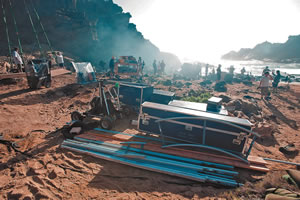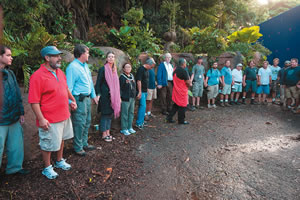Shooting A Film Starts With Scouting
Location, location, location - it’s as important for TV shows and films as it is in real estate. Colleen Gibbons, one of Hollywood’s top location gurus, takes MidWeek readers on a tour. Lights ... camera ... action! We’re so used to that instant action and glamour of the silver screen that it’s easy to overlook the many components that go into creating movies.

By .(JavaScript must be enabled to view this email address)
E-mail this story | Print this page | Archive | RSS

|
Lights ... camera ... action! We’re so used to that instant action and glamour of the silver screen that it’s easy to overlook the many components that go into creating movies.
Location scouting, for example: What is involved in choosing each scene’s backdrop? With the influx of films and TV series basing their production in Hawaii lately, you’ll be watching the show and suddenly you say, “Hey, that’s China Walls. How on earth did they find that hidden spot?”
MidWeek recently got in touch with location manager Colleen Gibbons to hear about her latest project, Journey 2: The Mysterious Island, which just wrapped up filming on Oahu and is scheduled to hit theaters later this year..
“We were at Heeia Kea Boat Harbor, and because it was our first three days of filming, we were a little bit under the radar, and we didn’t have Johnny Depp on the film,” laughs Gibbons, referring to the latest very publicized sequel in the Pirates of the Caribbean series that was recently filming at the same harbor, attracting an onslaught of eager fans.
Journey takes place in the South Pacific, and our state’s generous tax incentives for film and TV projects helped secure Hawaii as the stand-in destination. Filming began at the end of October, but Gibbons had begun scouting almost four months earlier. Lots of Internet research and photos from local film studios gave her an initial idea of suitable outdoor spots for various scenes. Then Gibbons visited each tentative location.
“I always go personally - I don’t take anybody,” says Gibbons, whose location scouting expertise also contributed most recently to Secretariat and Little Fockers. “I was the only scout on (Journey). Scouts each have different tastes - we have a different way of communicating and we have a different way of photographing things too. You always want to look at things for yourself as the location scout or manager because I might just walk at a different angle, which will completely change the whole tenor of the picture or the feeling of the location.”

|
Gibbons isn’t just considering aesthetics when she goes out on the prowl.
“We’re kind of like turtles, we have to carry everything with us,” she explains. “When you’re a movie company, moving 200 people around, with dozens of trucks, tractor-trailers, trailers and 40-footers - you have a lot of equipment on the ground and a lot of people, so there are places that are more difficult for us to access.”
Also, the company is shooting in digital 3D, which means plenty of additional cameras and equipment. China Walls was doable, but as much as Gibbons wanted nearby Spitting Cave, it was impractical as far as access. Same with Lanai Lookout, the first lookout on the right after Hanauma Bay, so the crew settled on the more customary filming location, Halona.
Night filming and something that is plentiful in Hawaii, especially at this time of year - yup, rain - presented additional challenges.
“For night shoots, we have to light for picture (the movie) as well as our work area, for safety issues,” says Gibbons. “We were at Judd Trail at night and (because of scheduling demands) it had to be on a Friday, but the state does not allow people to do work on weekends on Judd Trail, so that meant that everything that we brought in had to be out by 6 a.m. on Saturday.

|
“It’s not exactly dry back there. We’re movie companies, but we’re like armies - we just have to keep marching forward. It takes a certain amount of hours to lay the electric cable or put the lights up, or if you need a platform for the camera, or to build a camera crane. And it takes at least half that many hours to undo everything. We had to bring in extra labor and work through the night in order to get everything out to meet that deadline of being off the trail, and that’s a confined space to have a lot of people.”
Shooting in urban surroundings presented further obstacles. Finding a place in populated areas that can accommodate base camp not only involves parking logistics, but making sure the crew is able to easily get to their equipment and that actors can quickly get from their trailers to the set. As Gibbons notes, “The old adage ‘time is money’ is more true in our business than in most.”
Also, setting up in what might seem like ideal locations like parks or boat harbors might disrupt athletic practices or folks who have their boats docked nearby.
In all, Journey filmed at about eight Oahu locations, but predominantly in various parts of Waimea Valley and Kualoa Ranch. Filming in Hawaii had its silver lining despite a persistent mud problem. At Kualoa, “the Morgan family and the employees helped us get through all of these not-so-insignificant emergencies, like when we got pieces of our equipment stuck in the mud and
Page 1 of 2 pages for this story 1 2 >
E-mail this story | Print this page | Comments (0) | Archive | RSS
Most Recent Comment(s):








